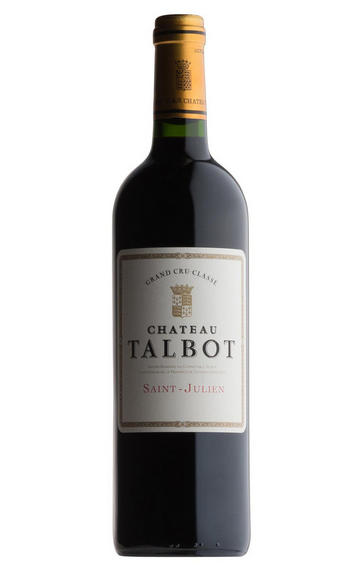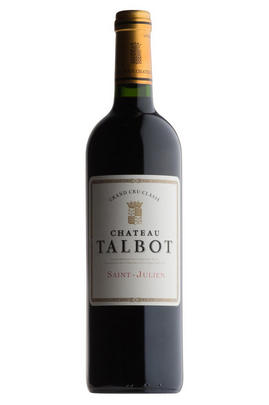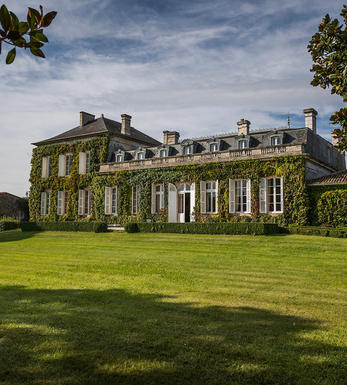
2020 Château Talbot, St Julien, Bordeaux

Critics reviews
Drink from 2026 to 2055
Neal Martin, Vinous (May 2021)
Drink from 2030 to 2045
Antonio Galloni, Vinous (June 2021)
Drink from 2026 to 2040
Jane Anson, Decanter (April 2021)
Deep purple-black colored, the 2020 Talbot storms out of the glass with powerful blackcurrants, raspberry leaves and baked plums scents, followed by suggestions of dried Mediterranean herbs, tobacco leaf and graphite. The medium-bodied palate delivers lovely freshness and an approachable chewiness, nicely framing the herb-laced black fruits, finishing savoury.
Drink 2024 - 2038
Lisa Perrotti-Brown MW, Wine Advocate (May 2021)
Drink 2029 - 2046
Jancis Robinson MW, JancisRobinson.com (April 2021)
James Suckling (April 2021)
Jeb Dunnuck, jebdunnuck.com (May 2021)
Drink 2030 - 2045
Michael Schuster, The World of Fine Wine (May 2021)
About this WINE

Chateau Talbot
Château Talbot is one of the best-known Bordeaux wine estates to a UK audience, not surprisingly because it takes its name from John Talbot, Earl of Shrewsbury, who in 1453 suffered the ignominy of losing the battle, and with it his life, which allowed Bordeaux and its vineyards to slip back into French control after belonging to the British Crown for over 340 years.
In the last century it has been owned by the Cordier family, and the red wine of the estate has long enjoyed a reputation for solid dependability. It is one of the largest estates in the Médoc and its 102 hectare single vineyard is situated inland from the Gironde River and west of the hamlet of St-Julien-Beychevelle.
Georges Cordier, who owned the property in the mid-20th century, was a great lover of white wine, and, determined to produce his own, took the highly unusual step of planting 5 hectares of Sauvignon Blanc and Semillon in his vineyard, producing his first crop of white wine in 1945 (Le Caillou Blanc de Ch Talbot). The aim is to make wine in a Burgundian style, aged in oak barrels, with the 80% Sauvignon Blanc imparting vivacity and acidity, while the 20% Semillon imbues the wine with weight, backbone and ageing potential.
Red wine from Talbot is typically a blend of Cabernet Sauvignon (66%), Merlot (26%), Cabernet Franc (3%), and Petit Verdot (5%) - the vinification includes 18 months maturation in small oak barriques (50% new).
Talbot has a reputation for consistency and is one of the most carefully made and reliable of the St-Julien Cru Classé clarets. The best examples are richly aromatic with a bouquet of cedarwood and vanilla scented cassis fruits and with a palate packed with well-delineated, ripe, black fruits and finely integrated tannins. It is classified as a 4ème Cru Classé.

St Julien
St Julien is the smallest of the "Big Four" Médoc communes. Although, without any First Growths, St Julien is recognised to be the most consistent of the main communes, with several châteaux turning out impressive wines year after year.
St Julien itself is much more of a village than Pauillac and almost all of the notable properties lie to its south. Its most northerly château is Ch. Léoville Las Cases (whose vineyards actually adjoin those of Latour in Pauillac) but, further south, suitable vineyard land gives way to arable farming and livestock until the Margaux appellation is reached.
The soil is gravelly and finer than that of Pauillac, and without the iron content which gives Pauillac its stature. The homogeneous soils in the vineyards (which extend over a relatively small area of just over 700 hectares) give the commune a unified character.
The wines can be assessed as much by texture as flavour, and there is a sleek, wholesome character to the best. Elegance, harmony and perfect balance and weight, with hints of cassis and cedar, are what epitomise classic St Julien wines. At their very best they combine Margaux’s elegance and refinement with Pauillac’s power and substance.
Ch. Léoville Las Cases produces arguably the most sought-after St Julien, and in any reassessment of the 1855 Classification it would almost certainly warrant being elevated to First Growth status.
Recommended Châteaux: Ch. Léoville Las Cases, Ch.Léoville Barton, Ch Léoville Poyferré, Ch. Ducru-Beaucaillou, Ch Langoa Barton, Ch Gruaud Larose, Ch. Branaire-Ducru, Ch. Beychevelle

Cabernet Sauvignon Blend
Cabernet Sauvignon lends itself particularly well in blends with Merlot. This is actually the archetypal Bordeaux blend, though in different proportions in the sub-regions and sometimes topped up with Cabernet Franc, Malbec, and Petit Verdot.
In the Médoc and Graves the percentage of Cabernet Sauvignon in the blend can range from 95% (Mouton-Rothschild) to as low as 40%. It is particularly suited to the dry, warm, free- draining, gravel-rich soils and is responsible for the redolent cassis characteristics as well as the depth of colour, tannic structure and pronounced acidity of Médoc wines. However 100% Cabernet Sauvignon wines can be slightly hollow-tasting in the middle palate and Merlot with its generous, fleshy fruit flavours acts as a perfect foil by filling in this cavity.
In St-Emilion and Pomerol, the blends are Merlot dominated as Cabernet Sauvignon can struggle to ripen there - when it is included, it adds structure and body to the wine. Sassicaia is the most famous Bordeaux blend in Italy and has spawned many imitations, whereby the blend is now firmly established in the New World and particularly in California and Australia.


Buying options
Add to wishlist
Description
Cabernet Sauvignon 76%, Merlot 21%, Petit Verdot 3%
The 76% Cabernet Sauvignon is a record for Talbot, up from last year’s record of 69%. From those figures, the direction of travel is clear: more structure, more definition and more power. Some of Talbot’s more loose-limbed charm remains, and it’s to the wine’s advantage. Among the classic graphite and cedar notes are those wonderfully familiar touches of woodland, and a certain breadth. This is a step up from years past; there is now complexity and dimension. Jean-Michel Laporte and his team have made great progress.
Drink 2028-2042
wine at a glance
Delivery and quality guarantee